Iceberg Heaven! (Written on Jan 13, 2014)
All morning patches of clear water and patches of fog brightened and obscured our view, respectively. At the ice edge we have today plus three more days – so find more whales was todays’ motto!
With 10 seconds notice from Mr. Jenner, a beautiful iceberg on our starboard asked to be photographed! On deck I clicked away, the white contrasting with the turquoise, under-water view. While concentrating on a portion with many striations from water erosion, a piece from the top fell hitting the water with a crash! Next, another piece dislodged which changed the balance and suddenly the piece that I was photographing rotated and moved 15 m into the air! More ice fell on each side with huge crunching sounds and much splashing, as pieces hit the water and bounced every which way! Within only 2 minutes, the shape of the iceberg had totally changed! I got ninety-odd still shots from the Albatross deck, while on the fly-bridge Inday filmed Tas taking images with her phone right as the berg fell apart dramatically!
Interested to see just how deeply the icebergs extend, Curt measured another one nearby. At the surface 20 m of ice was showing at the surface and the sonar indicated 110 m extended below underwater. Four-fifths really are beneath the water.
Thinking of the early explorers one is reminded of the ‘Race to the Pole’ between the Brit, Scott and the Norwegian, Amundsen. Captain Robert Falcon Scott aboard Terra Nova whom with four others, Edward Wilson, Lawrence Oates, Edgar Evans and Henry Bowers pushed their way to the South Pole on January 17, 1912 only to find Norwegian Roald Amundsen whom had travelled to the Antarctic on board Fram, had beaten them by 35 days. Amundsen sincerely wished to conquer the North Pole but he changed his plans by 1800,when he learned that American Robert E. Peary claimed to have reached 0900 North on April 6, 1909. Amundsen did not want Scott to know of his new southern plans and kept quiet, only telling three of his crew members. Upon arrival at Madeira, he informed the remainder of his men – all of whom were stunned. Soon after, on Oct 13, 1910 he sent his famous telegram to Scott in Melbourne: “Beg leave to inform you Fram proceeding Antarctic Amundsen”.
When Scott and his men realised Amundsen had conquered the South Pole, with sheer disappointment they began their fateful return journey to base. Sadly, this was a desperate tale of starvation and extreme cold. Delirious Evans died on March 17. A month later, Oates walked from their tent in a raging blizzard saying “I am just going outside and may be some time”. On March 21, a blizzard kept the remaining three in their tent, with Scott’s last diary entry dated March 29. Scott’s journal stated “We shall stick it out to the end but we are getting weaker of course and the end cannot be far. It seems a pity but I do not think I can write more – R. Scott”
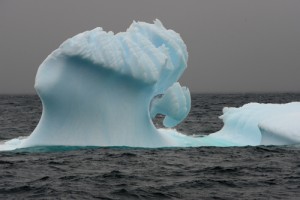
The left side then lifted out of the water with more of the berg falling from the area that was the water line…
Photo credit M. Jenner
A search party led by Lieutenant Atkinson found Scott’s last camp the following spring on November 12, 1912. The three men lay peacefully in their tent almost buried in snow. Scott was in the middle, with one arm lying across the body of his friend Wilson. Atkinson and his men let down the tent over the bodies where they lay and built a cairn over them. Scientists have calculated that the grave is approximately 15 m under the surface snow and 15 miles nearer the edge of the ice shelf. In the distant future, the bodies will be carried by an iceberg out into the Antarctic seas. Their legacy will remain.
Another famous expedition was Shackletons’ exploration of the southern seas aboard Endurance. In the Weddell Sea pack ice, despite Britain declaring war on Germany on August 4, 1914, Shackleton and his crew, (given the go ahead to continue exploring), pushed further and further through ever-narrower leads. However, on January 19, 1915, Endurance became stuck and finally on November 21 it was crushed by the grinding ice floes and sunk. Shackleton and his men lived on the ice for 5 months before mounting a rescue mission sailing three small boats to Elephant Island. Finding this island uninhabited, Shackleton and five others sailed 1300 km across the open sea in one of the boats to seek help from the sealers at South Georgia. The 6.9 m vessel James Cairn and six men successfully reached South Georgia, completing an epic navigational feat. Arriving at King Haakon Bay, the three men then hiked for 36 hours over the 1800 m mountain range to reach the Stromness whaling station on May 20, 1915. Their strong odours, apparently alarmed the station personnel. A whaler was dispatched that night to retrieve the three men left at Haakon Bay on the other side of the island and then after three failed attempts a Chilean ship was commissioned and all of the 22 men were finally rescued on August 30. Remarkably, no human loss of life occurred during all of these events. Enormous human courage and determination marked these expeditions in which huge difficulties were faced head-on, some successfully and others not so. As I read and re-read these accounts, I sincerely appreciated the courage of the explorers of old, understanding that they had paved the way for the explorers of the present.
Our modern voyage, WAVES Expedition (Whale Song Antarctic Voyage for Ecosystem Studies) is different on many levels. With a specialled vessel for polar travel and geared for listening, Whale Song is an excellent stage for cetacean research in the Antarctic. Well-supplied with food, water and fuel – she is a strong, warm little ship caring well for her crew. The team has been out-fitted in tasteful Eddie Bauer clothing, all of the items being extremely soft and warm. Each piece, beit a top or pants or a jacket, have been carefully designed to be practical with many styled features and are very comfortable to wear. To prepare for visual surveys or to stay on deck working with whales, one must be dressed in a suitable suite of gear. We are experiencing down to -180C with the wind chill, so we layer. This is the layering process: we are becoming good firemen – as in able to get ready very quickly if there is a whale sighting! Mostly we just have to apply to top few layers with each sighting. I begin with a merino wool undergarment singlet, then merino base-layer long-sleeved top, mid-layer fleece, micro-pillow down jacket and then the outer jacket which is water/wind/snow proof. Merino base-layer pants, fleece-lined pants and outer snow pants complete the leg complement. Merino socks inside our -20 or -40-rated Canadian snow-boots keep our toes toasty warm and hands wear liner gloves (complete with scanning thumb and pointer finger pads for electronic equipment), as well we have an outer pair of ski gloves and even another outer mitt, if necessary. A balaclava, a neck fleece and a beanie with ear covers finishes the head gear, beneath a helmet fitted with a GoPro. Sunglasses or ski-goggles are the final touch! I really am the MICHELIN man! The only other thing holding the whole thing together is my PFD (Personal Floatation Device) or lifejacket, worn over the whole shabang! With water in the minus range – we better not fall in.
Noon Observations Jan 13, 2014
Lat/Long: 640 28.6 S 1240 10.3 E
Dry Bulb Temp: -0.50C
Wet Bulb Temp: -0.50C
SST (Sea Surface Temp): -0.30C
COG (Course Over the Ground): 2520
SOG (Speed Over the Ground): 4.6 knots
Barometer: 996 Hp
Beaufort SS (Sea State): 4
WS (Wind Speed): 12-15 knots, fog, light snow
WD (Wind Direction): W
Swell: NW 1 m
Wildlife: Black-bellied storm petrel, 3 Southern Bottlenose Whales.
WT: KCGSM – 8
Antarctic Fact: Nuclear fallout from atomic tests conducted during the 1950’s and 60’s shows up clearly in ice cores drilled from the Antarctic ice sheets, and can be linked to specific, datable events.
Antarctic Slang: GRID – coordinate system designed to allow navigation at the South Pole, where all ‘directions’ are north; Grid North is the Prime Meridian, Grid South 1800 longitude, and so forth.
Steaming bowls of pumpkin and tomato soup filled our tummies along with Restys’ Pasta Antarctica (spaghetti with salami/cream/chillie) and warmed bread as we cruised through the fog. Crunching on Tas’s caramel popcorn I was terrified of breaking a tooth. But at the same time, I was comforted by the fact that I knew that I have dental resin in our medical kit. And I also know Curt our Surgeon General, will not be afraid to use it! I am just afraid of my dentist upon return to Freo, if we ever do have to use this stuff! He usually says don’t let your husband fix you with any resin. Probably good advice! Patches of fog came and went but mostly came… Please clear so we can see what is around us. Even when we had humpback whales all around us, they were very quiet and not vocalising, as on the breeding grounds. I guess the krill doesn’t bring out as much trill in the male humpback whales, as the females do on the breeding grounds! Same old story!
In the 1230 sonobuoy deployment we heard a repetitive sound that Curt kept describing as a “Wookie” from Star Wars. Have we been at sea too long already? I think so! On the acoustic screens Curt and Rob searched for calls and on the fly-bridge we looked and looked… The fog came and went and we froze and warmed as we rotated through visual obs and the wheelhouse recording duties. Finally, at 1816, whales were sighted from the wheelhouse! Three dark bodies were seen in the flat, glassy calm water. Relief! A sonobuoy detected the unusual clicking sounds and the Russ indicated that the dorsal and body they had seen clearly from inside the wheelhouse, was of three Southern Bottlenose whales. Three blows in the first sighting were followed by another three blows and on one of the whales’ surfacing, Russ and I took “Lochness Monster” photos of an individual. From these, we could identify the upright dorsal fin and scarred body of a Southern Bottlenose Whale! Great, and most interesting – especially as the chart had shown a depth reading of 327 m with most of the surrounding area being greater than 2000 m and so Curt had suggested there might be critters near this “seamount’. Indeed, there were.
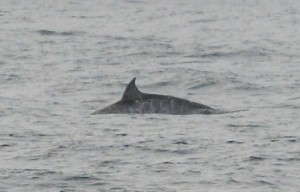
The characteristic dorsal fin and linear marks on a Southern Bottlenose whale seen just before dinner.
Photo credit M. Jenner
Fog and light snow filled the day. The snowmen, Daffy the Duck and Stumpy the Snowman, created yesterday morning are still standing on the teak box on the fly-bridge at 2100. They look great and are great mascots, as we travel the Antarctic! When we came in from our first and only whale sighting of the day, Restys’ dinner was ready and smelling yummy! Roast beef with roast potatoes, sweet potatoes, fresh lettuce salad and buttered broccoli! Yum! We finished with camembert and baguette – delicious!
With a grey, glassy calm sea and grey sky we plod westwards. I am certain I will pass out with pleasure, when I see a blue sky!
Mich

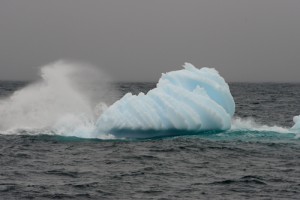
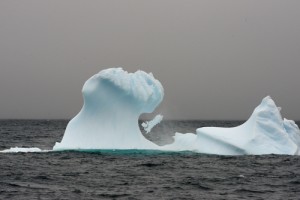



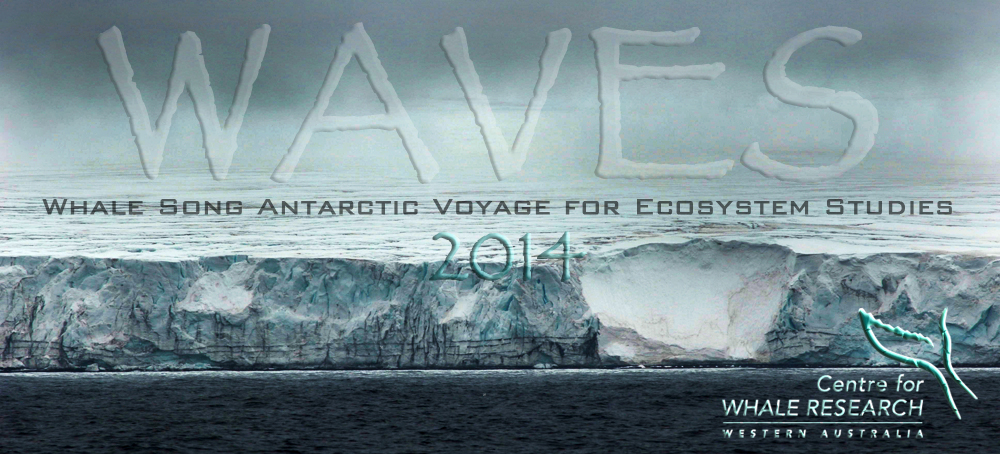










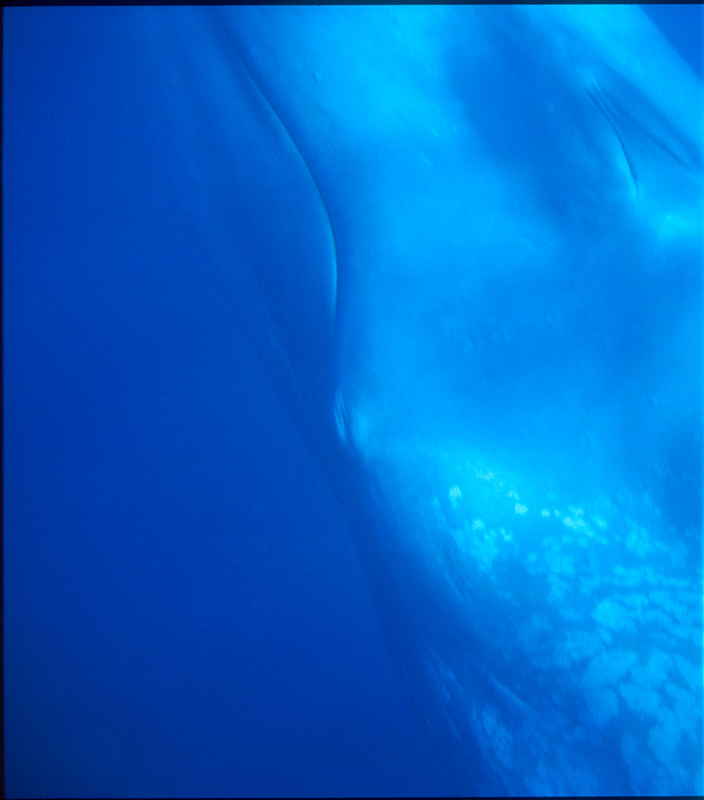
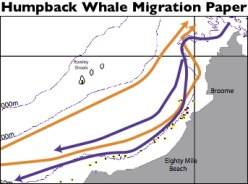
No comments yet.